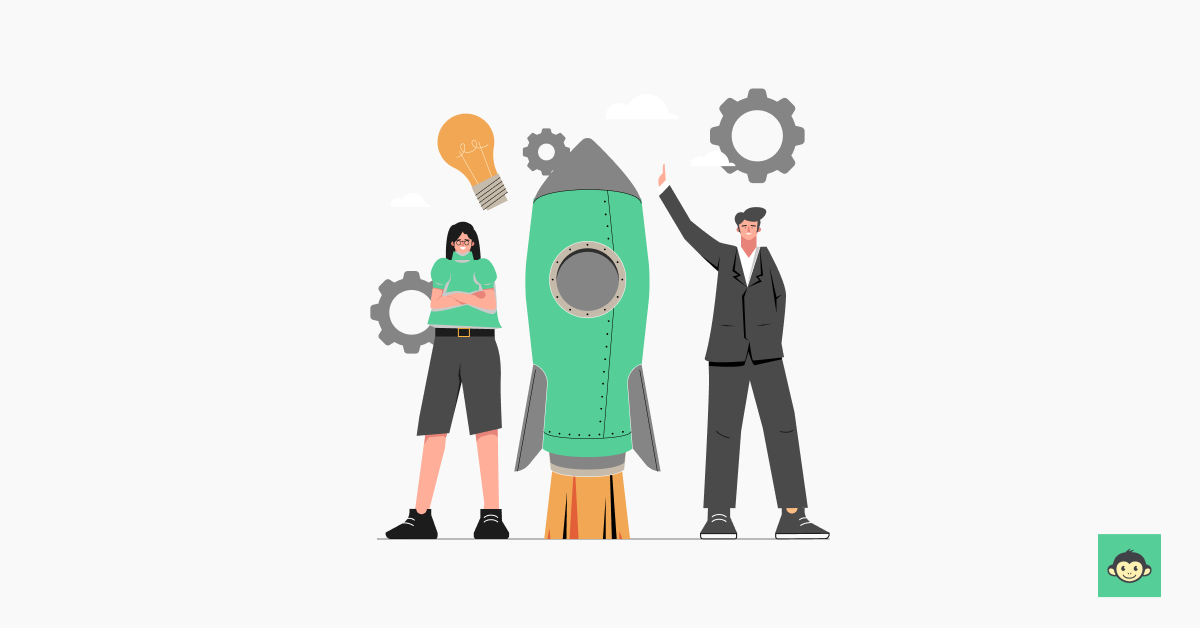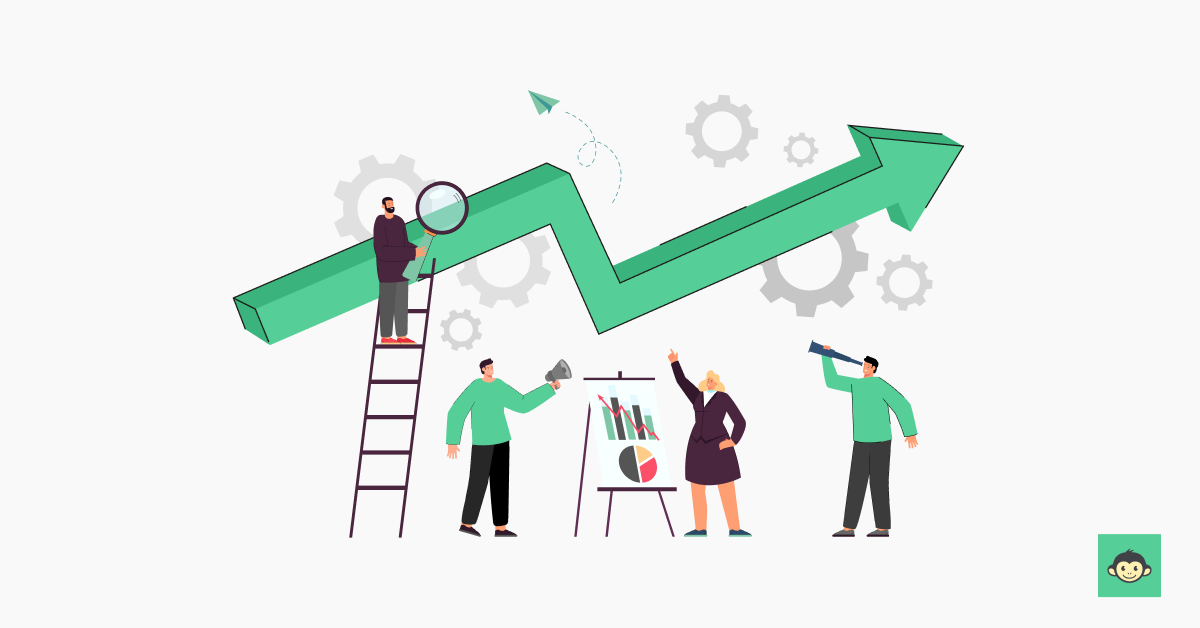What is internal mobility: How does it contribute to employee development at the workplace

In today's dynamic business landscape, organizations are increasingly recognizing the importance of internal mobility as a strategic tool for talent management and employee development. This concept underscores the idea that talent should be cultivated and leveraged from within, rather than solely seeking external candidates for new opportunities.
This article will delve into the world of internal mobility, exploring what internal mobility refers to and how it contributes to employee development and unlocks a treasure trove of benefits for both your employees and your organization.
We'll cover the different types of internal mobility, the key advantages it offers, and how you can create a program that fosters a culture of growth within your company.
What is internal mobility or talent mobility in HR?

Internal mobility in HR refers to the movement of employees within an organization, whether it's transitioning from one role to another, moving between departments, or climbing up the corporate ladder.
Organizations consider internal mobility important as it is a strategic approach that emphasizes utilizing the existing workforce and talent pool to fill open positions and develop employees' skills to meet the organization's evolving needs.
Internal mobility programs are structured initiatives designed to facilitate this movement, creating opportunities for existing employees to explore different career paths within the same organization.
These programs can take various forms, such as job rotation schemes, or internal talent mobility marketplaces, or career development plans tailored to individual aspirations and organizational requirements.
One of the key aspects of internal mobility is its role in fostering talent development and addressing skills gaps within the workforce. By enabling employees to acquire new skills and experiences through internal opportunities, organizations can bridge skill deficiencies without necessarily resorting to external hiring.
Building your own talent marketplace not only benefits the employees by enhancing their career prospects but also contributes to the overall agility and resilience of the organization.
Internal mobility plays a vital role in employee retention and satisfaction. When employees see clear pathways for career progression within their current organization, they are more likely to stay engaged and committed. Knowing that their employer values their growth and development can boost morale and loyalty.
By encouraging employees, reducing turnover rates and the associated costs of recruitment and training, you can tell quite simply that an internal mobility program is really quite helpful!
From a strategic standpoint, the internal mobility strategy aligns with the concept of talent mobility, which emphasizes the fluid movement of talent across different roles and functions within an organization.
This approach not only ensures that critical positions are filled with competent internal candidates but also creates a dynamic and adaptable workforce capable of responding to changing business needs.
Internal mobility is essential for nurturing a culture of continuous learning and growth within an organization. By providing employees with opportunities to expand their skills, explore new roles, and advance their careers, organizations can unlock the full potential of their existing talent pool while fostering a more engaged and resilient workforce.
What is the culture of internal mobility?

The culture of internal mobility within an organization refers to the shared values, beliefs, and practices that prioritize and encourage the movement of employees across various roles, departments, and career paths within the company.
It's characterized by a commitment to nurturing and retaining talent from within and providing ample opportunities for career development and advancement without the need for external hiring.
This culture fosters an environment where employees feel empowered to explore different roles, acquire new skills, and pursue their career aspirations within the organization.
It also emphasizes transparency, communication, and support from leadership to ensure that employees are aware of available opportunities and have the resources they need to succeed in their chosen paths.
A strong culture of internal mobility promotes agility, innovation, and engagement while enabling the organization to leverage its existing talent effectively to meet its strategic objectives.
Why does internal mobility matter to existing employees?

Organizations are constantly seeking ways to optimize their talent management strategies to stay ahead. One powerful approach gaining momentum is internal mobility– the practice of facilitating movement and progression of employees within the organization.
This proactive approach not only harnesses the existing talent pool effectively but also nurtures a culture of continuous learning, skill development, and innovation.
- Leverage existing talent pool: Internal mobility helps organizations leverage their existing talent pool effectively, enabling them to fill open positions with qualified internal candidates rather than relying solely on external hires. This not only saves time and resources associated with recruitment but also promotes continuity and stability within the workforce.
- Talent development: Internal mobility contributes to talent development and retention by providing employees with opportunities for career growth and advancement. When employees see clear pathways for progression within their organization, they are more likely to stay engaged and committed, reducing turnover rates and the costs associated with replacing skilled workers.
- Skill gaps: Internal mobility allows organizations to address skills gaps and adapt to changing business needs more efficiently. By enabling employees to acquire new skills and experiences through internal opportunities, organizations can build a more versatile and resilient workforce capable of meeting evolving challenges and opportunities.
- Continuous learning: Internal mobility fosters a culture of continuous learning and innovation within the organization. When employees are encouraged to explore different roles and pursue their interests, it stimulates creativity, collaboration, and knowledge sharing, leading to improved performance and competitiveness.
How do you handle internal mobility as a leader?

As a leader, handling internal mobility involves several key strategies:
Promoting a culture of internal mobility
- Foster a culture that values internal talent development and encourages employees to explore new opportunities within the organization.
- Communicate the benefits of internal mobility to employees, highlighting how it contributes to their professional growth and the organization's success. An effective internal communication plan can further ensure that these opportunities are clearly understood and embraced by everyone within the company.
- Lead by example by actively supporting and participating in internal mobility programs and initiatives.
Providing clear pathways for advancement
- Work with HR to establish transparent career paths and development opportunities for employees, outlining the skills and experiences required for advancement.
- Provide regular feedback and coaching to employees to help them identify their strengths, areas for improvement, and potential career paths within the organization.
- Ensure that performance evaluations and promotions are based on merit and aligned with the organization's goals and values.
Facilitating skills development
- Identify skills gaps within the organization and collaborate with HR to develop training programs and resources to address them.
- Encourage employees to pursue learning and development opportunities, such as workshops, courses, and certifications, to enhance their skills and readiness for new roles.
- Support employees in acquiring new skills and experiences by offering stretch assignments, job rotations, and cross-functional projects.
Ensuring fair and transparent processes
- Implement clear and equitable processes for internal job postings, transfers, and promotions, ensuring that all employees have equal access to opportunities based on their qualifications and performance.
- Communicate openly with employees about available opportunities, selection criteria, and expectations, providing feedback and guidance throughout the application and selection process.
- Address any concerns or grievances related to internal mobility promptly and transparently, demonstrating a commitment to fairness and employee satisfaction.
Building relationships and networks
- Encourage employees to build relationships and networks across different teams and departments, facilitating collaboration, knowledge sharing, and career exploration.
- Provide opportunities for employees to connect with mentors, sponsors, and peers who can offer guidance, support, and insights into potential career paths.
- Recognize and celebrate internal mobility successes, highlighting employees who have successfully transitioned to new roles or made significant contributions to the organization through their mobility experiences.
By implementing these strategies, leaders can effectively manage internal mobility, empowering employees to reach their full potential and driving organizational success.
Internal mobility: How does using existing talent benefit employee development?

Organizations recognize the importance of nurturing and developing their workforce to remain agile and innovative. One powerful strategy for achieving this is through internal mobility – the practice of facilitating movement and growth opportunities for employees within the organization.
Internal mobility not only benefits employees by offering skill enhancement and career exploration but also plays a vital role in fostering professional growth, personalized development, and increased engagement.
- Skill enhancement: Employees gain the chance to acquire new skills and experiences through exposure to diverse roles and responsibilities within the organization.
- Career exploration: It enables employees to explore different career paths and roles, allowing them to discover their strengths, interests, and areas for growth.
- Professional growth: Through internal mobility, employees can advance their careers within the organization, progressing from entry-level positions to more senior roles over time.
- Personalized development: Internal mobility programs often include personalized development plans tailored to each employee's career aspirations, providing targeted support for their growth and advancement.
- Increased engagement: Offering internal mobility opportunities demonstrates the organization's commitment to employee development, leading to higher levels of engagement, motivation, and job satisfaction.
- Retention of top talent: By investing in employee development and providing clear pathways for advancement, organizations can retain their top talent, reducing turnover and the costs associated with recruitment and training.
- Adaptability and agility: Employees who participate in internal mobility programs develop a broader skill set and a deeper understanding of the organization, making them more adaptable and better equipped to respond to changing business needs.
- Leadership development: Internal mobility often includes opportunities for leadership development, allowing employees to develop the skills and competencies necessary for future leadership roles within the organization.
8 Internal mobility types that you should know in 2024

Internal mobility encompasses various types of transitions within an organization:
- Horizontal mobility: Employees move to different roles or departments at a similar level of responsibility, allowing for skill development and broadening of experience.
- Vertical mobility: Employees progress upward within the same department of the organizational hierarchy, moving into roles with increased levels of responsibility and authority.
- Lateral mobility: Employees transition to roles at the same level of responsibility but in different departments or functional areas, facilitating cross-functional collaboration and skill diversification.
- Job rotation: Employees temporarily assume different roles or responsibilities within the organization to gain exposure to various aspects of the business and develop a well-rounded skill set.
- Promotional mobility: Employees are promoted to higher-level positions based on their performance, skills, and potential, enabling career advancement and recognition of achievement.
- Developmental mobility: Employees participate in formal training or development programs designed to prepare them for future roles within the organization, such as leadership development programs or talent pipelines.
- Project-based mobility: Employees work on short-term projects or initiatives outside of their regular jobs. Role-to-role mobility offers opportunities to learn new skills, collaborate with different teams, and contribute to strategic objectives.
- Temporary mobility: Employees take on temporary assignments or roles to fill short-term needs within the organization, such as covering for a colleague on leave or supporting a special project.
Common internal mobility challenges leaders face and how to overcome them?

Leaders may encounter several challenges when managing internal mobility within an organization. Here are some common challenges and strategies to overcome them:
Limited visibility of opportunities
- Challenge: Employees may not be aware of internal mobility opportunities due to poor communication or lack of transparency.
- Solution: Implement a centralized platform or system where employees can easily access information about available roles, development programs, and career paths. Regularly communicate about internal mobility initiatives and encourage managers to discuss career goals with their team members during performance reviews.
Skill gaps and readiness
- Challenge: Employees may lack the necessary skills or experience for the roles they aspire to, hindering their mobility.
- Solution: Provide targeted training and development programs to bridge skill gaps and prepare employees for future roles. Offer mentorship or coaching to help employees develop the competencies needed for advancement. Consider creating talent pools or succession plans to identify and nurture high-potential employees for key positions.
Resistance to change
- Challenge: Employees may resist moving to new roles or departments due to fear of the unknown, comfort with their current role, or concerns about job security.
- Solution: Foster a culture of continuous learning and adaptability by promoting the benefits of internal mobility and highlighting success stories of employees who have embraced change. Offer support and resources, such as career counseling or transition assistance, to help employees navigate transitions smoothly. Encourage open communication and address concerns proactively to alleviate fears and build trust.
Managerial support and buy-in
- Challenge: Managers may be reluctant to support internal mobility initiatives due to concerns about losing top talent or disruptions to team dynamics.
- Solution: Provide training and education for managers on the benefits of internal mobility and how to effectively manage transitions within their teams. Empower managers to have career development discussions with their direct reports and encourage them to support employees' growth and aspirations. Recognize and reward managers who actively promote internal mobility and mentor employees for future roles.
Equity and fairness
- Challenge: Employees may perceive internal mobility processes as biased or unfair, leading to disengagement and morale issues.
- Solution: Ensure that internal mobility processes are transparent, objective, and merit-based, with clear criteria for selection and advancement. Monitor and evaluate mobility practices to identify and address any disparities or biases. Encourage diversity and inclusion in talent development initiatives and strive to create equal opportunities for all employees to pursue career advancement.
What is an internal mobility program? How can it impact employee engagement

An internal mobility program is a structured initiative within an organization designed to facilitate the movement of employees across different roles, departments, or locations.
It provides employees with opportunities to explore new career paths, develop skills, and advance within the organization through job rotations, promotions, transfers, or special projects. Such programs can have a significant impact on improved employee retention and engagement by:
- Committing to employee growth: Demonstrating a commitment to employee development and career growth, which can increase motivation and morale.
- Allowing for employee advancement: Providing clear pathways for advancement and recognition of employees' contributions, leading to higher job satisfaction.
- Building a culture of constant learning: Fostering a culture of continuous learning and skill development, where employees feel valued and supported in their professional growth.
- Building transparency: Promoting transparency and fairness in talent management practices, enhancing trust and loyalty among employees.
- Encouraging collaboration: Encouraging collaboration and knowledge sharing across teams and departments, fostering a sense of belonging and community within the organization.
- Encouraging accountability: Empowering employees to take ownership of their careers and pursue opportunities aligned with their interests and aspirations, resulting in increased engagement and commitment to organizational goals.
7 Key internal mobility strategies to try as a leader

Effective internal mobility programs are essential for fostering a dynamic and engaged workforce, driving employee growth and organizational success.
By facilitating ongoing career conversations, implementing formalized job posting systems, and providing training and development opportunities, organizations can empower employees to explore new roles and advance their careers within the company.
Promoting a culture of collaboration, offering mentorship programs, establishing clear evaluation criteria, and recognizing internal mobility efforts are vital components of a thriving internal mobility strategy.
- Facilitate ongoing career conversations: Encourage regular discussions between managers and employees to identify individual career aspirations, strengths, and areas for development.
- Implement a formalized internal job posting system: Establish a structured process for posting internal job opportunities and promoting them to employees.
- Provide training and development programs: Offer comprehensive training and development programs to equip employees with the skills and competencies needed for internal mobility.
- Promote a culture of knowledge sharing and collaboration: Foster a collaborative work environment where employees are encouraged to share knowledge, expertise, and best practices across teams and departments.
- Offer mentorship and coaching programs: Establish formal mentorship and coaching programs to support employees in navigating internal mobility transitions.
- Establish clear evaluation criteria for internal candidates: Define clear criteria and processes for evaluating internal candidates for promotion or lateral moves within the organization.
- Recognize and reward internal mobility: Celebrate employees' career milestones, achievements, and contributions to the organization through internal communications, awards, or incentives.
Internal mobility: 9 Best practices to know in 2024

Data-driven decision-making and personalized career development are essential components of effective talent management strategies.
By leveraging data analytics, offering personalized career plans, and fostering a culture of continuous feedback, organizations can empower employees, drive internal mobility, and cultivate a skilled and engaged workforce primed for success.
- Data-driven decision-making: Utilize data analytics and workforce planning tools to see employee growth, identify talent gaps, assess employee skills, and anticipate future workforce needs.
- Personalized career development plans: Offer personalized career development plans tailored to individual employees' aspirations, skills, and development areas.
- Proactive talent management: Take a proactive approach to talent management by actively identifying high-potential employees and nurturing their growth through targeted career development opportunities and internal mobility programs.
- Leadership development initiatives: Invest in leadership development initiatives that prepare employees for future leadership roles within the organization, enabling a pipeline of internal talent for key positions and driving succession planning efforts.
- Continuous feedback and coaching: Provide regular feedback and coaching to employees to support their professional growth and readiness for internal mobility opportunities, fostering a culture of continuous learning and improvement.
- Cross-functional collaboration: Promote cross-functional collaboration and knowledge-sharing initiatives to facilitate internal mobility and skill diversification, enabling employees to gain exposure to different areas of the business and expand their expertise.
- Transparent communication: Maintain transparent communication channels regarding internal career mobility, opportunities, processes, and criteria, ensuring that employees are informed and engaged in their career development journey within the organization.
- Inclusive talent practices: Implement inclusive talent practices that remove barriers to internal mobility for underrepresented groups, promoting diversity, equity, and inclusion within the workforce and fostering a culture of belonging.
- Measuring and monitoring progress: Establish key performance indicators (KPIs) and metrics to measure the effectiveness of internal mobility efforts, track employee upward mobility rates, retention rates, and employee satisfaction, and adjust strategies accordingly to drive continuous improvement.
Conclusion
Embracing internal mobility as a strategic imperative fosters a dynamic workplace where talent thrives, skills evolve, and organizations flourish. In today's ever-changing work landscape, platforms like CultureMonkey provide invaluable insights and tools to support and optimize internal mobility efforts.
By leveraging these platforms, organizations empower their greatest asset—their people—to reach their full potential.
With CultureMonkey, leaders can gain actionable insights into employee aspirations, skills, and career trajectories, enabling them to facilitate seamless transitions and growth opportunities within the organization.
This proactive approach not only enhances employee engagement and satisfaction but also drives innovation and competitiveness in the market.
By embracing internal mobility as a core aspect of talent management, organizations position themselves for long-term success, ensuring that they remain agile and responsive to the evolving needs of the workforce and the business landscape.
FAQs
What is another name for internal mobility?
Another term for internal mobility is talent mobility, which involves the movement of employees within an organization to different roles, departments, or locations. It's a strategic approach to maximizing talent potential, organizational effectiveness, and employee satisfaction by leveraging existing skills and fostering professional growth among employees.
What is internal and external mobility?
These two concepts are distinct from one another. Internal mobility is a corporate concept that encompasses transitions within an organization, including promotions or transfers, shaping career paths and organizational dynamics, fostering employee growth and retention effectively. In contrast, external mobility entails movement between different organizations, influencing career trajectories, contributing to broader industry knowledge, and expanding professional networks significantly and diversely.
What is an internal movement?
Internal movement encompasses shifts within an organization, such as promotions, transfers, or lateral moves. These movements not only affect individual career paths but also influence team dynamics, organizational culture, and talent development strategies, shaping the overall effectiveness and competitiveness of the organization.
What are the problems with internal mobility?
Challenges with internal mobility include addressing skill mismatches, overcoming limited awareness of available opportunities, and managing resistance to change among employees. Proactively tackling these obstacles necessitates implementing robust talent management strategies, fostering transparent communication channels, and cultivating a supportive organizational culture that prioritizes continuous learning and career development initiatives.
How do you handle internal mobility?
Managing internal mobility involves creating an environment within an organization that is conducive to talent development, providing opportunities for skill enhancement and career advancement, and implementing fair and transparent processes for internal job postings and promotions. By investing in internal mobility initiatives, organizations can unlock the full potential of their workforce, driving innovation, productivity, and employee engagement.



